I have grown Escobaria missouriensis for many years. I started in North Dakota as this is one of those bone-hardy cactus from the Northern Great Plains.
The form found in that part of the country grows very low to the ground (almost flat)tucked in amongst the short bunch grasses, on the dry sloping flanks of clay buttes and gravely knolls. It is confined to the south western portion of the state in what, for a better term, is know as the "bad lands". The spines are thin and wiry with few to no central spines. (a user friendly cacti) It can take considerable moisture and and in most years is the second cacti to bloom for me.(only preceded by Pediocactus) Fertile seed are encased in small bright red, berry shaped fruits ,that can persist attached to the plant for up to two years. There is some variation in spine coloration from white though amber. Once in a while a black spined plant may be discovered. These northern forms bloom with the blossoms in clusters. The petals are always a pale straw color with an embossed button of yellow stamens.
I do have another clone from a nursery that shows some variation in growth, and flowering habit. This plant grows in a higher domed cluster of stems with single flowers scattered across the mat. The flower color is a little richer with more golden hues. All in all a nice clone.
A friend in Reno grows several clones from north central New Mexico that are highly domed and ball shaped . they do not cluster as readily and the plentiful fruits are two to three times larger. (they look like someone took the time to decorate for Christmas) The flowers are a bronze color fading to gold at the center(the look like they are radioactive with the glowing centers)and larger than the two forms described.
The first two are of the Northern Great Plains form.
The next two are the nursery form.
The last two of the New Mexico form.


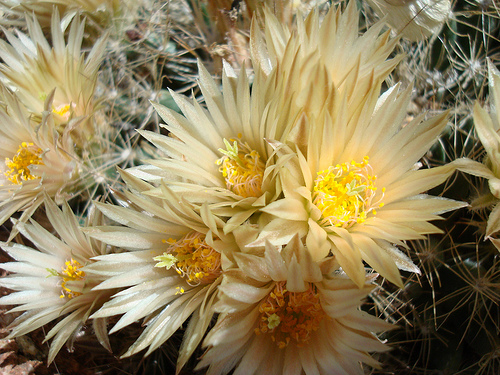
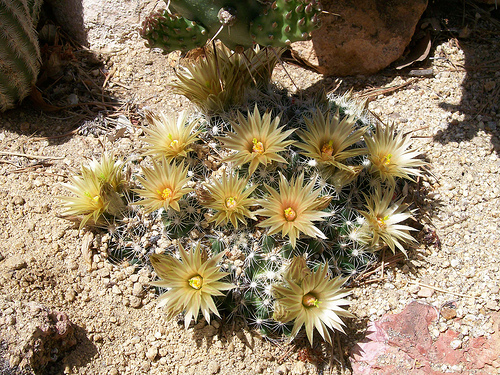
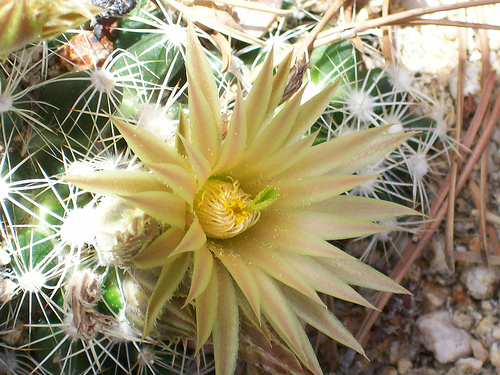
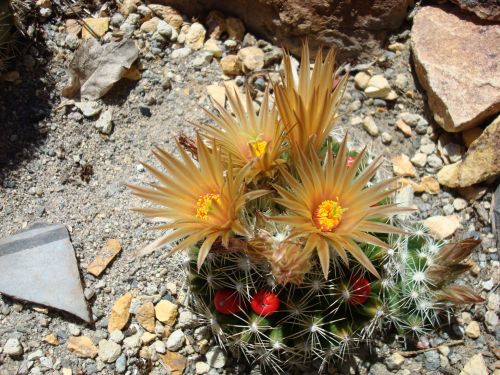
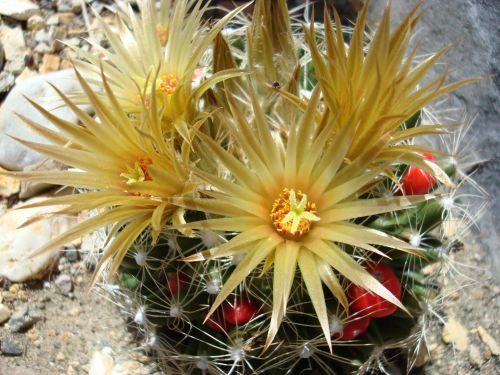
Comments
Trond Hoy
Re: Escobaria missouriensis
Fri, 04/16/2010 - 2:17pmI have "always" (since childhood) grown cacti indoors in pots. Now I am trying to find species to grow outside all year. But I think this is no easy task given the humid climate here with alternating freezing and raining in winter and cool summers.
But it is interesting to see pictures of well grown plants!
John P. Weiser
Re: Escobaria missouriensis
Fri, 04/16/2010 - 2:51pmHoy
I can see where that would be a problem.
A small list of Opuntia that tolerate winter wet.
O. humifusa
O. macrorhiza
O. polyacantha
O. fragilis
Mark McDonough
Re: Escobaria missouriensis
Fri, 04/16/2010 - 7:49pmJohn, I'm inspired by your posting, I do want to try some of these reputedly hardy cacti in a Northeastern USA setting. I like the last 2, the New Mexico forms best, but I'm willing to try any that will be hardy here. A well-known local native plant society garden here; the Garden In Th Woods, in Framingham, Massachusetts, has a number of cacti, mostly Opuntia, that have proved hardy here.
Richard T. Rodich
Re: Escobaria missouriensis
Fri, 04/16/2010 - 11:01pmSome excellent specimens! I have some E. missouriensis seed now, merely because it is a hardy cactus species here, and I too am more inspired with its beauty.
Trond Hoy
Re: Escobaria missouriensis
Sat, 04/17/2010 - 12:48amThanks, have to look for seed or plants!
Bowden (not verified)
Re: Escobaria missouriensis
Sat, 04/17/2010 - 10:27amHoy, I would also consider a few of the Echinocereus and Coryphantha/Escobaria species. Often different subspecies have different cold and wet tolerance. I have had success with E. viridiflora, and E. reichenbachii ssp. baileyii, Escobaria sneedii and Coryphantha vivipara ssp. vivipara. Pediocactus simpsonii has also been surprisingly hardy for me for a few years here. Cacti are easy to germinate but slow to grow on from seed. They do well with perfect drainage in a sandbed, gravelbed or trough, even a pot set on the ground for the winter, and good sun exposure. They often look dead during the winter, but become plump and alive looking when spring returns.
Trond Hoy
Re: Escobaria missouriensis
Sun, 04/18/2010 - 10:43amThank you, Paul. Now I have a good list with different species!
Sand, stone and gravel are no problem, sun is more difficult!
Richard T. Rodich
Re: Escobaria missouriensis
Sun, 04/18/2010 - 6:53pmExcept for Coryphantha/Escobaria, I now don't even plant my cactus seed until the warmest week of the year in July, when temps are 90 plus degrees. For me, cactus seeds germinate most readily then. And now that I know what has been devouring my little seedlings, I think I'll have good post germination success too.
Lori S. (not verified)
Re: Escobaria missouriensis
Sun, 04/18/2010 - 7:03pmAnd so... what is it that has the temerity to eat cactus seedlings??
Richard T. Rodich
Re: Escobaria missouriensis
Sun, 04/18/2010 - 10:15pmSlugs - before the cactus seedlings grow hardened spines. I would go out in the morning to find my tiny green "jelly beans" looking like they were sliced off at the surface. I never realized what was going on until I actually saw the culprit.
Trond Hoy
Re: Escobaria missouriensis
Sun, 04/18/2010 - 10:56pmHad been my first, second and third guess!!
Andy71 (not verified)
Re: Escobaria missouriensis
Sat, 05/26/2012 - 5:16amHere's a one from the Hots Springs, SD area that is a rather small clone. It also has a neat flower that has hot pinkish filaments that create quite a contrast to the straw colored petals.
[attachment=1]
[attachment=2]
E. missouriensis is one of the true hardy plants for cold areas with high rainfall. I haven't lost one yet while I have had several losses of E. vivipara.
John P. Weiser
Re: Escobaria missouriensis
Sat, 05/26/2012 - 5:41amVery nice flower on that one!! Love the pink filaments!!. Do you find that the flowers on the northern forms tend to open their flowers in clusters?
I know mine do that.
Andy71 (not verified)
Re: Escobaria missouriensis
Sat, 05/26/2012 - 6:08amThis one has always had only 1 or 2 flowers open at a time. Probably makes 6-8 buds per year but they open over a 3 week period. May just be my climate
Andy71 (not verified)
Re: Escobaria missouriensis
Sat, 05/26/2012 - 4:35pmRight on cue one of my own missouriensis seedlings flowered today as a 3 year old. Needed a bigger coin! No location data but the flower is much larger than the one above.
[attachment=1]
[attachment=2]
A nice deep color on this one
John P. Weiser
Re: Escobaria missouriensis
Sat, 05/26/2012 - 6:23pmThat should be a real looker when it gets bigger. Good Job!
Martin Tversted (not verified)
Re: Escobaria missouriensis
Sun, 05/27/2012 - 12:07amI have tried many forms of humifusa here in Denmark, and none have worked well - all fungused up, I agree that the other you mention are the ones Trond should use.
(Ill send you some later on Trond)
Martin
cohan (not verified)
Re: Escobaria missouriensis
Mon, 06/18/2012 - 11:55pmOne of my very favourite hardy cacti, for the flower colours- I much prefer these to the bright vivipara or similar shades of Echinocereus.. the 'open' bodies I don't like as well , but I'd tolerate them for those flowers :) Just have one little batch of seedlings, need to buy a bunch of other forms!